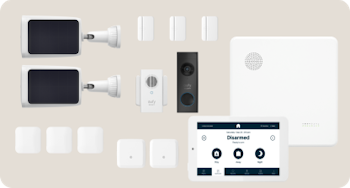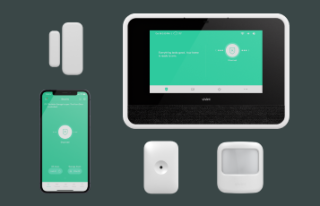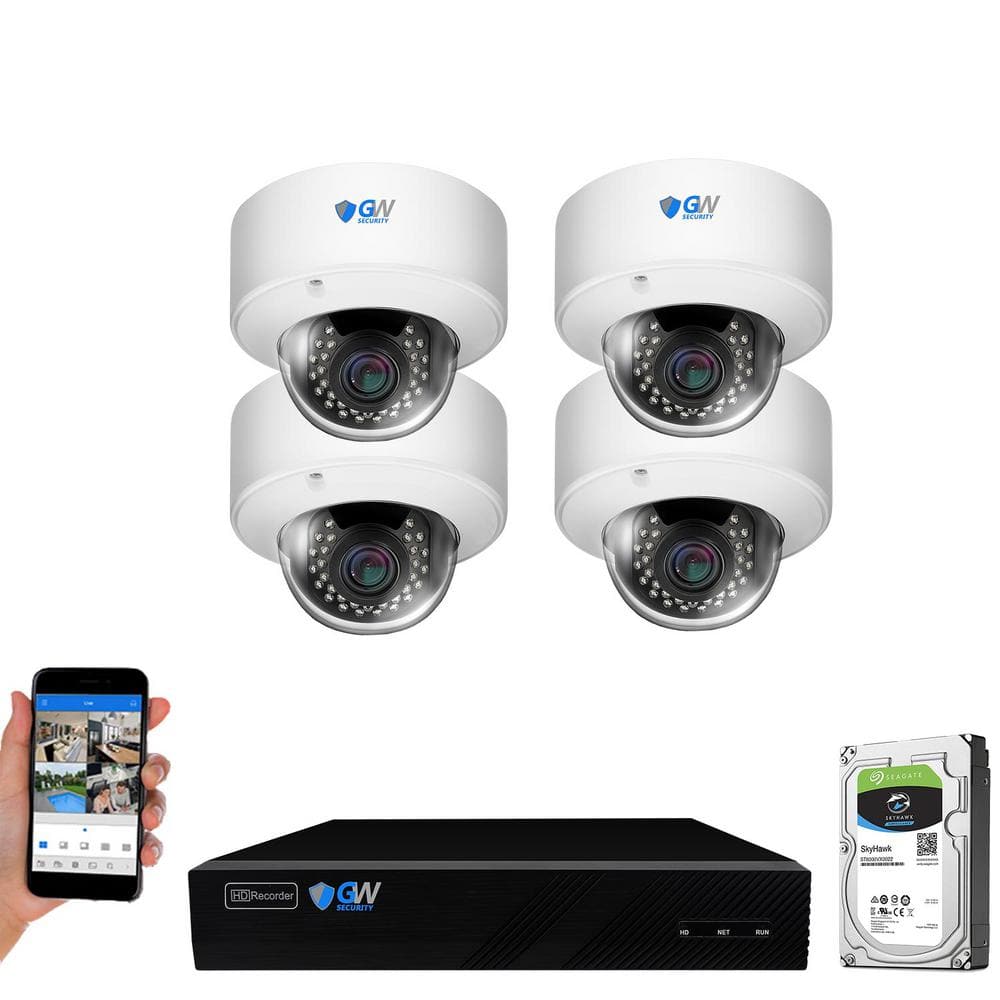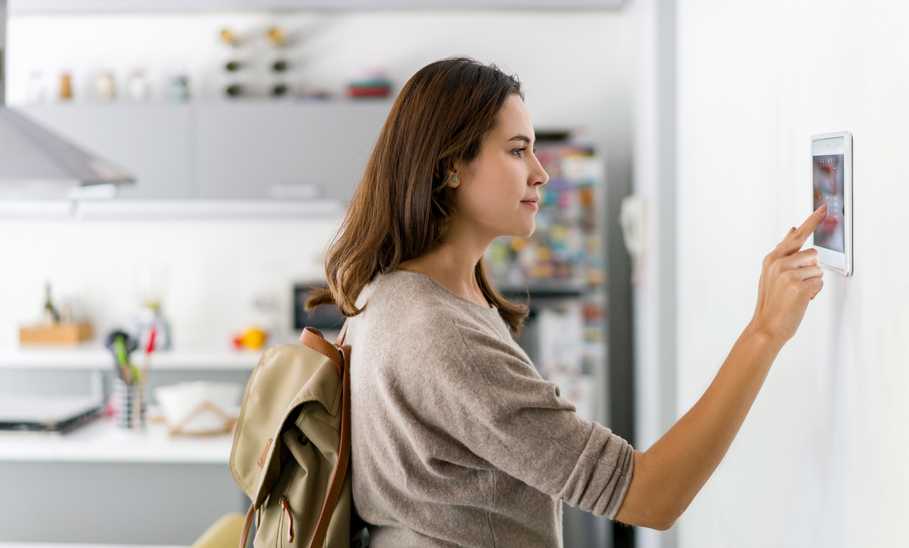A home security system protects you, your family, and your property from thieves and intruders, as well as monitoring for fire, carbon monoxide (CO2), and floods. In the past, consumers didn’t have many monitoring options, but today most companies offer varying levels of professional monitoring, as well as DIY capabilities via a companion app on your smartphone.
To get a better idea of the advancements in home security, I talked to several experts, including SafeHome home security and safety expert Rob Gabriele, Batten Safe home security and safety expert (and former law enforcement) Kirk MacDowell, and ADT Chief Product Officer Naveen Chhangani.
Our picks for best home security system
Best home security system for installation and convenience: Cove Smart Home Security

Cove Smart Home Security
Cove offers completely customizable security systems with a 60-day, risk-free trial period. Equipment options include a hub and alarm panel and Cove connect App (obviously, required), burglary and intrusion sensors, cameras, environmental detectors for smoke, carbon monoxide, and water leaks, and remotes that include medical alerts.
All the equipment is wireless and easy to install–Cove estimates on average, it takes about 27 minutes to complete. Cove offers professional monitoring plans starting at $17.99 per month with no contracts (these are required to receive alerts). Enroll in the Cove Plus Monitoring plan and receive a $5 per month credit to use toward the purchase of future equipment upgrades and additions.
Specifications
- Equipment costs: Custom options/packages
- Monitoring options: Cove Basic, Cove Plus
- Monthly monitoring costs: Starts at $17.99
- Contract lengths: Month to month
- Installation options: DIY or DIY with phone guidance
- Smart platform integration: Alexa, Google Home
Pros:
- Completely customizable
- Easy to install
- Cove App allows you to receive text alerts
Cons:
- Professional monitoring plan required
The bottom line:
Easy to install, completely custom security systems (no packages available) with required month-to-month, professional monitoring starting at $17.99 per month.

Simplisafe 12-piece wireless home security system
27% offSave $99
With optional professional monitoring (no contract required), Alexa and Google Assistant compatibility, and 12 easy-to-install components, Simplesafe offers one of the best DIY security systems out there. This bundle, appropriate for medium- to large-sized homes (two to four bedrooms), includes a base station with battery backup, smash-safe keypad, two motion sensors, five entry sensors, a SimpliCam security camera, and a key fob and panic button. The SimpleSafe App allows you to control and monitor your system no matter where you are, while the security camera shows you everything that’s happening in real time. The panic button also features a silent option so you can signal for help without drawing attention.
Specifications
- Equipment costs: $399.99
- Monitoring options: Police, fire, and emergency medical with subscription
- Monthly monitoring costs: $19.99-$29.99
- Contract lengths: Month to month
- Installation options: DIY or professional
- Smart platform integration: Alexa, Google Home
Pros:
- Option to add video verification with live monitoring package
- Base station has battery and cellular backup
- No long-term monitoring contracts required
Cons:
- No outdoor security camera
The bottom line:
Easy-to-install, DIY security system for larger homes with a security camera and optional month-to-month professional monitoring.

Vivint Security Systems
Vivint offers a range of component packages as well as complete customization for a security system that best suits your home. All packages include a touchscreen control panel, intrusion detection, 24/7 monitoring, and the mobile app. The premium package adds full home automation with voice control, video security, vehicle protection, and stored video clips. You can customize with doorbell and outdoor cameras, as well as smart sensors that monitor door and window breaching. Vivint provides free professional installation and a lifetime warranty on all of its equipment and devices.
Specifications
- Equipment costs: Starting at $449
- Monitoring options: Starter, premium, and premium plus
- Monthly monitoring costs: Start at $30 per month
- Contract lengths: 42 months
- Installation options: Professional
- Smart platform integration: Alexa, Google
Pros:
- Free professional installation
- Customizable
- Excellent home automation with premier package
Cons:
- Equipment more expensive than others
The bottom line:
Advanced security system with free professional installation, customizable equipment packages, and robust smart home automation features.

Ring 8-piece security system
40% offSave $100
The Ring Alarm eight-piece system (best suited for one to two-bedroom houses) includes a base station with battery backup, keypad, four contact sensors, a motion detector, and a range extender that ensures all the devices will have a signal. With a subscription, you’ll receive mobile notifications via the Ring App. Add voice control by combining with an Alexa device such as the Echo Dot. Monitoring plans start at $3.99 per month for the basic option. The Protect Pro option adds extra features such as alarm cellular backup, 24/7 monitoring, and local video storage.
Specifications
- Equipment costs: $249
- Monitoring options: Protect Basic, Protect Plus, and Protect Pro Subscriptions
- Monthly monitoring costs: $3.99, $10, $20
- Contract lengths: Month to month or yearly (yearly provides discounts)
- Installation options: DIY
- Smart platform integration: Alexa, Google Home
Pros:
- Affordable equipment and monitoring options
- Advanced home integration features via Alexa
- Easy DIY installation
Cons:
- Some reviewers report base station pairing issues
The bottom line:
Alexa-compatible DIY security system at a great price with affordable professional monitoring plans.

Abode 4-piece wireless security system
9% offSave $30
For smaller homes, this Abode four-piece wireless security system offers peace of mind, easy DIY installation, and optional professional monitoring. There’s a security hub with a backup battery, a motion sensor that takes pictures, a mini door/window sensor, and a key fob. The hub features Z-wave frequency so you can easily add compatible smart home accessories including locks, lights, and other sensor-equipped devices. This means that via the Abode app, you can operate third-party devices like Kwikset locks and Nest thermostats. Add an Abode security camera with two-way for around $35 to secure your front door (also functions as an indoor camera). Easily integrated with Alexa.
Specifications
- Equipment costs: $279
- Monitoring options: Optional professional
- Monthly monitoring costs: $22.99
- Contract lengths: Month to month
- Installation options: DIY
- Smart platform integration: Alexa, Google Home, Apple Homekit
Pros:
- Motion sensors take photos
- Lots of equipment options
- Compatible with Z-wave and Zigbee
Cons:
- Adding extra sensors gets pricey
The bottom line:
DIY security system compatible with Z-wave and Zigbee smart home devices with optional professional monitoring.

FrontPoint Home Security System
This Frontpoint system features a hub and app, keypad, fob, three door or window sensors, and a motion sensor, flood sensor, and home defense kit. A 13-piece system adds three more window sensors, another motion sensor, and an indoor camera for a total cost of $300. Additional equipment options (available in other packages or by designing your own custom system) include an indoor camera, doorbell camera, touchscreen, smart door lock, glass break and motion sensors, and a flood sensor.
Outdoor cameras provide ground zone monitoring when someone or something crosses your “virtual tripwire.” Peel-and-stick installation of components make this system easy to install. Step-by-step instructions on the app will walk you through it if you need help. Plus, there’s a 30-day risk free trial.
Specifications
- Equipment costs: Start at $79.99
- Monitoring options: Professional
- Monthly monitoring costs: $24.99
- Contract lengths: 12 months
- Installation options: DIY
- Smart platform integration: Alexa, Google Home
Pros:
- 30-day trial
- Smart Home integration
- Easy DIY installation
The bottom line:
Easy-to-install starter home security system at a reasonable equipment price, with required 12- month contract if you want professional monitoring.
Best home security system for response times: Brinks Home Security
Response time depends very much on law enforcement. Gabriele has personally tested many systems for Safehome, and the industry standard across the board–from the time an alarm is triggered to when the monitoring system makes the call to the homeowner–is 30 seconds. The time it takes after that for police to show up depends on where you live.
The industry is trying to move away from central stations verbally talking to 911, instead talking directly via computer aided dispatch to law enforcement's dispatch center through something called ASAP (automated secure alarm protocol) to PSAP (public service answering point), which cuts down response time measurably. Basically, this cuts out the human element in the equation; an actual person does not have to make the call and explain what is going on.
The Brinks system features a cellular backup that connects to the strongest major wireless provider in your area (it’s not the only system that does this). Completely customizable, Brinks systems include a Home Hub, companion app, motion sensors, door and window sensors, glass break sensors, and a garage door sensor, plus optional security cameras and a full range of home automation and life safety devices.
Specifications:
- Equipment costs: Starts at $360
- Monitoring options: Professional
- Monthly monitoring costs: Start at $39.99 a month
- Contract lengths: 36 months
- Installation options: Professional or DIY
- Smart platform integration: Alexa, Google Home
What we like:
- DIY installation
- App is easy to use
- Installation experts available via phone
What we don't Like:
- Three-year monitoring contract
The bottom line:
Full featured professional security system with DIY installation and three available levels of professional monitoring (no self-monitoring option).

GW Security 4-camera system
GW security system cameras offer continuous recording with scheduled automation if desired. Back up the recordings at a remote computer managed through Surveillance Camera AI software. Each camera features night vision capabilities up to 100 feet, plus weatherproofing against rain, snow, and heat with a tamper proof construction. The system includes four wired cameras, control box and video recorder, and cables.
Specifications
- Equipment costs: $625.00
- Monitoring options: DIY
- Monthly monitoring costs: N/A
- Contract lengths: N/A
- Installation options: DIY
- Smart platform integration: None
Pros:
- Clear video picture
- DIY installation and monitoring
- Excellent night vision
Cons:
- No professional monitoring option
The bottom line:
Weatherproof, vandal-resistant, professional grade security cameras with 4K resolution, color night vision, and wide angle recording, that run continuously.
Best home security system for AI and live security guard monitoring: Deep Sentinel Security Camera

Deep Sentinel Security Camera
Deep Sentinel Security combines a smart processor with AI technology and optional live monitoring by an actual person, who reviews activity on your camera feed (only for outdoor cameras) in real time when alerted. This security system provides surveillance of the outside of your property only. A three-camera kit costs $899 while a six-camera one will set you back $1,499.
The more cameras you have, the higher your monthly monitoring will cost. The wireless Deep Sentinel cameras wake when motion is detected within their range and immediately begin recording. According to the company, the Hub AI separates potential threats from harmless events such as cars driving by. If it decides there’s a real threat, an actual human guard analyzes the situation and intervenes if necessary.
Specifications
- Equipment costs: Starting at $499
- Monitoring options: DIY or live security guard
- Monthly monitoring costs: Starts at $100 for one camera
- Contract lengths: 12 months
- Installation options: DIY
- Smart platform integration: None
Pros:
- Advanced AI
- DIY installation
- 24/7 professional monitoring
Cons:
- High monitoring fees with no self-monitoring option
The bottom line:
Outdoor security camera set up with advanced AI and live guard monitoring via video, with relatively steep monthly monitoring charges.
How we selected the best home security systems
I talked with professionals in the industry who have personally tested a range of systems for ease of installation and connectivity, monitoring options, smart home integration, and response times. I also consulted online reviews and customer forums to weigh costs, connectivity, digital security, and mobile app features to come up with the best choices for a variety of instances and preferences, including both DIY and professional options.
What to consider before buying home security system
Chhangani recommends the following minimal features for whatever system you choose: Door/window sensors, a motion sensor, smoke and CO2 detector, security camera, and a smart doorbell with camera that allows you to communicate with visitors.
Equipment
Security systems include a range of equipment options, like door and window sensors, motion sensors, security cameras, and other alarms such as smoke and CO2. All have a central hub that connects all the equipment and most include a companion app. After the hub, entryway sensors are the next most important thing, says Gabriele. He recommends a sensor on every first-floor entry point to your home.
When deciding on equipment, MacDowell says to have some sort of interior protection, like a motion detector in case someone cuts the glass and sneaks in that way. People with pets often think they can’t use motion detectors but this is no longer true–motion detectors have come a long way over the years. “They have motion detectors now that go up to 40 to 50 pounds, so they know the difference between a dog and a human on all fours because of analytics,” MacDowell explains.
Installation
“While professional installations typically run from $100 to $200, a lot of times you can get that waived when you sign up for a monitoring plan,” says Gabriele. “A DIY installation will likely take one to two hours, depending on how many components you have, while a professional one could take up to a full day.” Chhangani adds that installing a basic ADT system usually requires two to three hours, while their DIY system often takes less than an hour.
Wireless DIY systems usually have components with a peel-and-stick application so you’re able to just position them where you want, then connect via the system hub and app. Many of the DIY companies also provide phone support if you need assistance during the installation.
If you opt for professional installation, make sure your installer also educates you on how to use the app, says MacDowell. “Plus, they should clean the home afterward; things like smudging a door jamb or sweeping up shavings from any drilling.”
Monitoring options
Self-monitoring systems alert you directly (usually via an app) when they perceive a threat. You review the data and contact the proper authorities yourself. Professional monitoring means that the security company receives an alert, at which time they call you. If you do not respond (or you do and confirm there is indeed something wrong) they trigger an alert to authorities.
MacDowell, who has been in the security business for 44 years, says that while people want security, in his experience, many do not want to pay a monthly monitoring fee, which is where DIY self-monitoring systems like Abode, Scout, and others come in. “Usually, that's absolutely fine,” he says, “but there are times where DIY may not be enough; for instance, I was on a plane last night for multiple hours, and if that alarm system activated while I was on a flight, there's nothing I could have done.”
Years ago, monitoring options were either self or professional but today, says MacDowell, some companies offer ‘monitoring on demand’, which means you can turn it on for six days (or however many you want) at a time. The companies that offer this service tend to be local, regional ones, so if this sparks your interest, research security companies in your area.
The advantage of professional 24/7 monitoring is, of course, having trained experts continually monitor your system, responding quickly to emergencies on your behalf. “This option offers greater peace of mind, especially if you're often away from your phone or home, as it ensures your property is always under vigilant supervision,” says Chhangani.
Most companies also provide tiered options for professional monitoring. “There are usually three tiers,” says Gabriele. “Basic, smart home, and smart home with video.” Basic includes just intrusion protection (activating when a door or window sensor is tripped), while smart home adds integration of other smart devices, and smart home with video means you receive real time playback and recordings of suspicious activity. Fire and CO2 alarms generally come with medium tiered packages.
Smart home integrations, automation features, and connectivity
Smart home integration means your security system seamlessly connects with other smart devices in your home, says Chhangani. These include smart locks, lights, thermostats, cameras, and more. Automation controls allow you to set up rules for energy efficiency such as auto-adjusting thermostats and lights when you’re away. Connecting to Alexa, Google, or other smart platforms lets you control everything with voice commands.
Which system is best for you depends on which products you have, says Gabriele, whether that’s Apple Home, Google Home, Amazon Alexa, or Smart things by Samsung. These days, most products work with most of the platforms, but before investing in a system, make sure it works with the one you’re most comfortable with. “Are you a Google person? Or an Amazon person? Do you have an Android? Those types of things. I don’t really recommend one over another,” he says.
Costs
There are three costs to consider when deciding on which company or system to go with: Equipment, installation, and monitoring. The more separate components you want, obviously the more money you’ll have to spend. Many companies offer packages of their most frequently used equipment. Starter kits usually begin at around $100, while more robust systems can cost as much as $800 to $900.
Digital security
Digital security refers to the tools used to keep your data safe online; things like two-factor and multi-factor authentication, firewalls, antivirus protection, and control of your data. As far as your security system goes, you want an app and hub that protects your personal data and also protects against external hackers. Most apps will allow you to set up a two-factor authentication in order to change any settings. Also, ensure the software on your smartphone is up to date.
Mobile application
These days, almost every security system available also has a companion app, allowing you to connect the components, arm and disarm the system, receive alerts, and access video footage if you have cameras. All the systems included here offer a companion app and, in this day and age, you should expect that. Even my building’s (I live in a six-story NYC apartment building) video doorbell system has a companion app so I can see who is buzzing my apartment when I'm not home.
Advantages of home security systems
MacDowell says security systems can be tied to lifestyle. For instance, when he arms his system at night in a home mode (as opposed to away), it also sets the thermostat back and turns off all the lights but one. “In the morning, I get up and I say ‘awake’, and the lights turn on, the heater turns on and if I wanted, I could even have it start the coffee pot,” he says. “But that's my job, so I do that.”
Frequently asked questions (FAQs)
Is there a security camera without a monthly fee?
There is! GW Security offers various camera packages that allow for self-monitoring, as do any of the DIY systems with a security camera on this list.
How much does a home security system cost?
This depends on how many components you need. Costs range from $100 all the way up to $900 or more. MacDowell says the national average is about a dollar per square foot, so for a 2,000-square foot home, it would be about $2,000. While that may sound expensive, he says that when he started in the industry, it was probably $3 per foot. “It's really come down, and now consumers get a blend; security, video, smoke detection, carbon monoxide detection, water and leak detection, all combined into the security platform,” he says. “So that's why it's still expensive, but you do get total security.”
Do I need a home security system in an apartment?
Installing a security system in your apartment offers peace of mind, especially when used with smoke and CO2 detectors. If you live in a city, you’ve likely read news reports about apartment fires (or even explosions) that cause significant damage. Having an alert system that detects smoke and CO2 early can be both life and property saving.
DIY, wireless systems (including ADT’s Self Start, Cove, Abode, Ring, and others) that you can take with you if you move offer an excellent choice for apartment dwellers. “These kits allow for a personalized, cost-effective solution that is easy to both install and move,” says Chhangani.
Can I install a home security system if I rent?
Absolutely, confirm all our experts–that’s the beauty of wireless systems. “Make sure to check your rental agreement and understand the rules set by your landlord or the Homeowners Association,” says Chhangani. “Many landlords support measures that increase their properties' safety and security.”
What's the difference between a wired and wireless alarm system?
Wireless security systems utilize Wi-Fi or Bluetooth to connect your components and monitor the system. A wired system means it’s hard wired into your home’s electricity. Wireless systems offer flexibility if you move or don’t want to put a bunch of holes in your walls. Hardwired systems work great if you’re interested in a complete smart home situation, or if you’re remodeling and can incorporate the installation at the same time.
How do water sensors work?
MacDowell says there are two ways to use this type of sensor. One way is to install the sensor by your water heater. “Put it at the bottom of the water heater so it’ll sense water if it breaks and activate the alarm,” he explains. You can also opt to put it on the pipe system that comes from the outside into the inside of your home. If water runs for too long, it will slowly shut that water completely off. “So, for instance, if the water in the pipes freeze and that pipe breaks and water keeps flowing and flowing and flowing, the system will shut the water down,” he says.
Water heaters refill themselves when their water gets low. If it keeps refilling itself and dumping water into the house, a sensor will catch that. MacDowell prefers the sensors that completely shut the water off from the outside, but they're a lot more expensive than the little sensors that simply detect if there's moisture on the floor.













